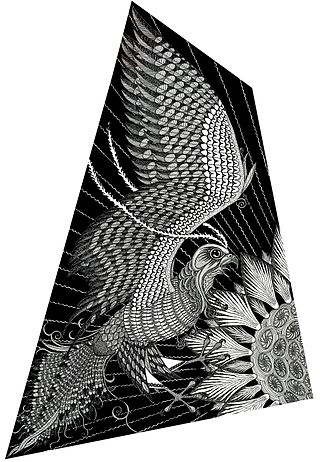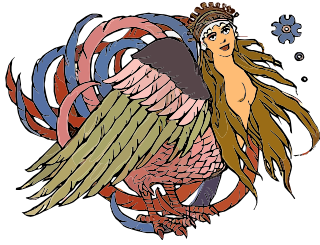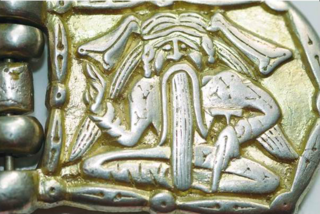
The Bannik is a bathhouse (banya) spirit in Slavic mythology. He is usually described as a small, naked old man with a long beard, his body covered in the birch leaves left over from well used bath brooms. Many accounts also claim that he is a shapeshifter and can appear as a local person to someone who stumbles across him, or even as a stone or coal in the oven heating the bathhouse. Slavic bathhouses resemble saunas, with an inner steaming room and an outer changing room. A place where women gave birth and practiced divinations, the bathhouse was strongly endowed with vital forces. The third firing was reserved for the bannik, and, given his inclination to invite demons and forest spirits to share his bath, no Christian images were allowed lest they offend the occupants. If disturbed by an intruder while washing, the bannik might pour boiling water over him, or even strangle him.

Leshy or Leshi is a tutelary deity of the forest in pagan Slavic mythology. As Leshy rules over the forest and hunting, he may be related to the Slavic god Porewit.
In Slavic mythology, notsnitsa, often referred in plural, is a nightmare spirit or demon that torments people and especially children at night. Other names for notsnitsa in East Slavic languages include kriksy, plaksy, plachky, plaksivicy, kriksy-varaksy, kriksy-plaksy, night hag, night maiden.

In Slavic mythology, the Raróg or Raróh is a fire demon, often depicted as a fiery falcon.

In the Slavic religious tradition, Domovoy (Russian: Домовой, literally "[the one] of the household"; also spelled Domovoi, Domovoj, and known as Polish: Domowik, Serbian: Домовик, Ukrainian: Домовик and Belarusian: Дамавік is the household spirit of a given kin. They are deified progenitors, that is to say the fountainhead ancestors of the kin. According to the Russian folklorist E. G. Kagarov, the Domovoy is a personification of the supreme Rod in the microcosm of kinship. Sometimes he has a female counterpart, Domania, the goddess of the household, though he is most often a single god. The Domovoy expresses himself as a number of other spirits of the household in its different functions.
The Komi Republic, sometimes simply referred to as Komi, is a republic of Russia situated in the northeast of European Russia. Its capital is the city of Syktyvkar. The population of the republic at the 2021 census was 737,853, down from 901,189 at the 2010 census.

The Komi are a Permian ethnic group who are indigenous to, and primarily inhabit a region around the basins of the Vychegda, Pechora and Kama rivers in northeastern European Russia. They mostly reside in the Komi Republic, Perm Krai, Murmansk Oblast, Khanty–Mansi Autonomous Okrug, and Nenets Autonomous Okrug in the Russian Federation.
Gabija is the spirit of the fire in Lithuanian mythology. She is the protector of home and family. Her name is derived from gaubti or from St. Agatha. Gabija is only mentioned in a list of Lithuanian gods by the Christian theologian Jan Łasicki in his treatise on idolatry. She is found in Lithuanian folklore.

The Alkonost is a legendary woman-headed bird in Slavic folklore. Alkonost is more likely an individual character, as was noted in some legends about this bird.

Mount Narodnaya is the highest peak of the Urals in Russia. Its elevation is 1,894 metres (6,214 ft). It is located on the border between Khanty–Mansi Autonomous Okrug in Tyumen Oblast and Komi Republic, the highest point being 0.5 km to the east from the border. The name may refer to Naroda River, which originates from the mount, located in the Research Range.

Yōsei is a Japanese word that is generally synonymous with the English term fairy (フェアリー). Today, this word usually refers to spirits from Western legends, but occasionally it may also denote a creature from native Japanese folklore. For example, according to an old folk belief from Iwate Prefecture, it was once feared that the yōsei could resurrect the dead. It is also mentioned that the people of Mt. Hōrai are small fairies that have no knowledge of great evil and so their hearts never grow old. The Ainu also tell of a race of small people known as the Koro-pok-guru in their folklore. Another fairy-like being from Japan is the Kijimuna, tree sprites told in the Ryukyuan religion of Okinawa.

Hungarian mythology includes the myths, legends, folk tales, fairy tales and gods of the Hungarians.
Gagana is a miraculous bird with an iron beak and copper claws featured in Russian folklore. She is said to live on the Buyan Island. The bird is often mentioned in incantations. It is also said this bird guards the Alatyr, alongside Garafena the snake.
Komi mythology is the traditional mythology of the Komi peoples of northern Russia.

Chai nenesi, is a name applied to Turkic spirits of water, commonly creeks. She is responsible for sucking people into swamps and lakes as well as killing the animals standing near the still waters.
In Slavic mythology, bolotnik, balotnik, bolotyanik or błotnik is a male swamp spirit. There are many descriptions of bolotnik. Usually he was portrayed as a man or an old man who has big, frog-like eyes, a green beard and long hair. His body is covered with dirt, algae and fish scales. The legends from the Vitebsk Governorate of Russia said that bolotnik is a dirty, fat, eyeless creature that motionlessly sits at the bottom of the swamp. In some accounts bolotnik is also said to have long arms and a tail. Just like the majority of Slavic water spirits, he would lure and drag people into the water if they get close to the edge. It is believed that bolotnik has neither wife nor children; in the other legends he is married to bolotnitsa, a female swamp spirit.

The Mooseman is an adventure video game developed by the Perm-based Russian studio Morteshka and released in 2017. The game is based on the mythology of Komi, as well as other Finno-Ugric peoples, and is an attempt at artistic reconstruction of mythological plots. The game tells the story of the Mooseman, the shaman and one of the seven sons of the creator god Yen, who must travel to the underworld to retrieve Shondi and save the world from the eternal cold.










